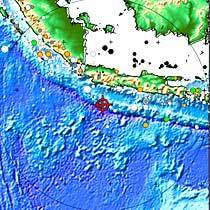The coast of British Columbia has long been considered as a high risk zone for earthquakes and underwater landslides that often cause tsunamis. Scientists now say Quebec and the East Coast should also brace for such hazard.
David Mosher, a marine geohazard expert at Natural Resources Canada, has studied Canada's deadliest tsunami that devastated fishing communities in southern Newfoundland in 1929.
The Grand Banks disaster triggered giant sea waves that killed 27 people and swept houses and fishing boats out to sea.
The tsunami was caused by an underwater landslide of relatively small scale. Mosher said that really surprised him.
"Even smaller underwater landslides can generate a tsunami that can cause significant loss of life and damage," said the Dartmouth, N.S., scientist who travelled to Quebec City for a geohazard conference.
That discovery prompted scientists to acknowledge that the tsunami-potential of the East Coast, considered a low-risk region, is probably larger than previously thought.
"People in the St. Lawrence Estuary and on the East Coast are much less aware of the risks because they don't encounter earthquakes very often," he said.

|
| ©National Oceanic and Atmospheric Administration/Bloomberg News
|
| An image from the National Oceanic and Atmospheric Administration, Pacific Tsunami Warning Center, showing the epicenter of an earthquake off the coast of Indonesia. A tsunami similar to the one triggered by the 2004 undersea earthquake off Indonesia could happen on Canada's West or East coasts, scientists say.
|
"Even more so now with the 1929 events fading from memory," he added.
Earthquakes are often the cause of landslides that can lead to a tsunami. That was the case in the Grand Banks disaster in 1929.
Mosher isn't trying to scare people and acknowledged that storm events probably represent a bigger hazard to communities than underwater landslides.
"I don't think the risk is high because the recurrence rate is so low on a human time scale, but I think people ought to be aware of the fact that this could be happening," he said.
Canada has the longest coastline in the world - 243,000 kilometres - and has a high potential for tsunami, Mosher stressed.
"We have the biggest offshore territory in the world and we also have to take on the responsibility of understanding what is going on in these territories," he said.
The southwestern part of B.C. is the region in Canada most prone to landslides and tsunamis, followed by the St. Lawrence estuary in second place.
Geologists have often warned that the Pacific region needs to prepare for a repeat of the major earthquake of January 1700 that is believed to have generated a giant tsunami that swept across the Pacific.
Mosher believes that a tsunami of the magnitude of the one that hit the Indonesian island of Sumatra in 2004 could hit the coast of B.C.
"The tectonic situation off Sumatra is identical to the one of southwestern B.C.," he said.
"A mega event similar to what happened off Sumatra is a likelihood in hundreds of years time scale, but we don't know whether it could happen tomorrow or 400 years from now," he added.
The recurrence rate of such a massive quake is estimated between 300 and 700 years.
"It's really hard to predict, but we can point out regions that are more susceptible than others to allow for planning," he stressed.
During the Grand Banks tsunami of 1929, there was a delay of nearly two hours between the earthquake and the tsunami impact.
Mosher noted that it doesn't not give a lot of time to move population from low coastal areas.
"Currently, authorities are not prepared to react under such short notice," he said.
Reader Comments
to our Newsletter